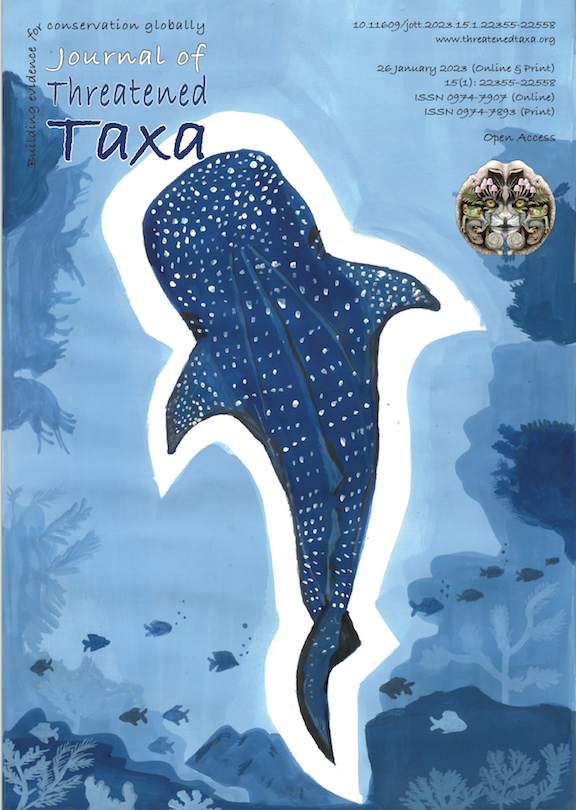A checklist of avifauna of Mangalore University, Karnataka, India
Main Article Content
Abstract
The study of the avifaunal diversity was carried out in the Mangalore University campus, located in Dakshina Kannada District, Karnataka from 2013 to 2021, in and around the campus. A total of 150 bird species belonging to 18 orders and 56 families were recorded during the study. Out of these, the study area supports five species which are endemic to the Western Ghats. The feeding guild analysis revealed that the insectivorous group had the highest number of species (53 species). The study provides baseline data for monitoring the avifauna in the campus and demonstrates the importance of the area in bird conservation.
Article Details

This work is licensed under a Creative Commons Attribution 4.0 International License.
Authors own the copyright to the articles published in JoTT. This is indicated explicitly in each publication. The authors grant permission to the publisher Wildlife Information Liaison Development (WILD) Society to publish the article in the Journal of Threatened Taxa. The authors recognize WILD as the original publisher, and to sell hard copies of the Journal and article to any buyer. JoTT is registered under the Creative Commons Attribution 4.0 International License (CC BY), which allows authors to retain copyright ownership. Under this license the authors allow anyone to download, cite, use the data, modify, reprint, copy and distribute provided the authors and source of publication are credited through appropriate citations (e.g., Son et al. (2016). Bats (Mammalia: Chiroptera) of the southeastern Truong Son Mountains, Quang Ngai Province, Vietnam. Journal of Threatened Taxa 8(7): 8953–8969. https://doi.org/10.11609/jott.2785.8.7.8953-8969). Users of the data do not require specific permission from the authors or the publisher.
References
Ali, S. (2002). The book of Indian Birds. Oxford University Press, New Delhi, 326 pp.
Ali, S & S.D. Ripley (1987). Compact handbook of the Birds of India and Pakistan together with those of Bangladesh, Nepal, Bhutan and Sri Lanka. Oxford University Press, Delhi, India, 737 pp.
Clements, J.F., T.S. Schulenberg, M.J. Iliff, S.M. Billerman, T.A. Fredericks, B.L. Sullivan & C.L. Wood (2019). The eBird/Clements Checklist of Birds of the World: v2019 https://www.birds.cornell .edu/clementschecklist/download/. Electronic version accessed 09 May 2021.
Gadgil, M. (1996). Documenting diversity: An experiment. Current Science 70: 36–44.
Grimmett, R., C. Inskipp & T. Inskipp (2011). Birds of the India, Pakistan, Nepal, Bangladesh, Bhutan, Sri Lanka and the Maldives. Princeton University Press, New Jersey, 528 pp.
Harisha, M.N., K.S.A. Samad & B.B. Hosetti (2021). Conservation status, feeding guilds, and diversity of birds in Daroji Sloth Bear Sanctuary, Karnataka, India. Journal of Threatened Taxa 13(7): 18738–18751. https://doi.org/10.11609/jott.6855.13.7.18738-18751
Jha, C.S., C.B.S. Dutt & K.S. Bawa (2000). Deforestation and land use changes in Western Ghats, India. Current Science 79: 231–238.
Kazmierczak, K. (2006). A field guide to the birds of India. Pica Press Illustrated United Kingdom, 352 pp.
Nazneen, K., K.V. Gururaja, A.H.M. Reddy & S.V. Krishnamurthy (2001). Birds of Kuvempu University Campus, Shimoga dirstrict, Karnataka. Zoos’ Print Journal 16(8): 557–560. https://doi.org/10.11609/JoTT.ZPJ.16.8.557-60
Norbu, L., P. Thinley, T. Wangchuck, U. Dechen, L. Dorji, T. Choephel & P. Dorji (2021). On the high bird diversity in the non-protected regions of Trashi-yangtse District in Bhutan. Journal of Threatened Taxa 13(9): 19274–19292. https://doi.org/10.11609/jott.6843.13.9.19274-19292
Paul, E. & R.J. Cooper (2005). New opportunities for bird conservation research. In: Ralph, C., R. John & D. Terrel (eds.). Bird Conservation Implementation and Integration in the Americas: Proceedings of the Third International Partners in Flight Conference, Asilomar, California (Vol. 2). US Department of Agriculture, Forest Service, Pacific Southwest Research Station: 1008–1017 (Vol. 191).
Praveen, J., R. Jayapal & A. Pittie (2021). Checklist of the Birds of India (v5.0). http://www.indianbirds.in/india/. Electronic version accessed 29 March 2021.
Praveen, J., S. Subramanya & V.M. Raj (2018). Karnataka checklist: Corrections and additions. Indian BIRDS 14(4): 127–128.
Purvis, A. & A. Hector (2000). Getting the measure of biodiversity. Nature 40: 212–219.
Rajashekara, S. & M.G. Venkatesha (2016). Seasonal incidence and diversity pattern of avian communities in the Bangalore University Campus, India. Proceedings of the Zoological Society 70: 178–193.
Rajashekara, S. & M.G. Venkatesha (2017). Additions to the birds of Bangalore University Campus (BUC), India. Proceedings of the Zoological Society 72: 197–201. https://doi.org/10.1007/s12595-017-0231-1
Ramitha, M. & K. Vijayalaxmi (2001). A Checklist of birds in and around Mangalore University Campus, Karnataka. Zoos’ Print Journal 16(5): 489–492. https://doi.org/10.11609/JoTT.ZPJ.16.5.489-92
Schlegel, J. & R. Rupf (2010). Attitudes towards potential animal flagship species in nature conservation: a survey among students of different educational institutions. Journal for Nature Conservation 18: 278–290.
Shivashankar, M., S. Subramanya, D. Karuthedathu & A. Shivaprakash (2011). A note on pelagic bird sightings off the Mulki coast of southern India. Indian Birds 7(3): 70–71.
SoIB (2020). State of India’s Birds, 2020: Range, Trends and Conservation Status. The SoIB Partnership, 50 pp.
Vinayak, D.C. & S.V. Mali (2018). A checklist of bird communites In Tamhini Wildlife Sanctuary, the northern Western Ghats, Maharashtra, India. Journal of Threatened Taxa 10(3): 11399–11409. https://doi.org/10.11609/jott.3377.10.3.11399-11409
Yashmita-Ulman & M. Singh (2021). Bird composition, diversity and foraging guilds in agricultural landscapes: a case study from eastern Uttar Pradesh, India. Journal of Threatened Taxa 13(8): 19011–19028. https://doi.org/10.11609/jott.7089.13.8.19011-19028

